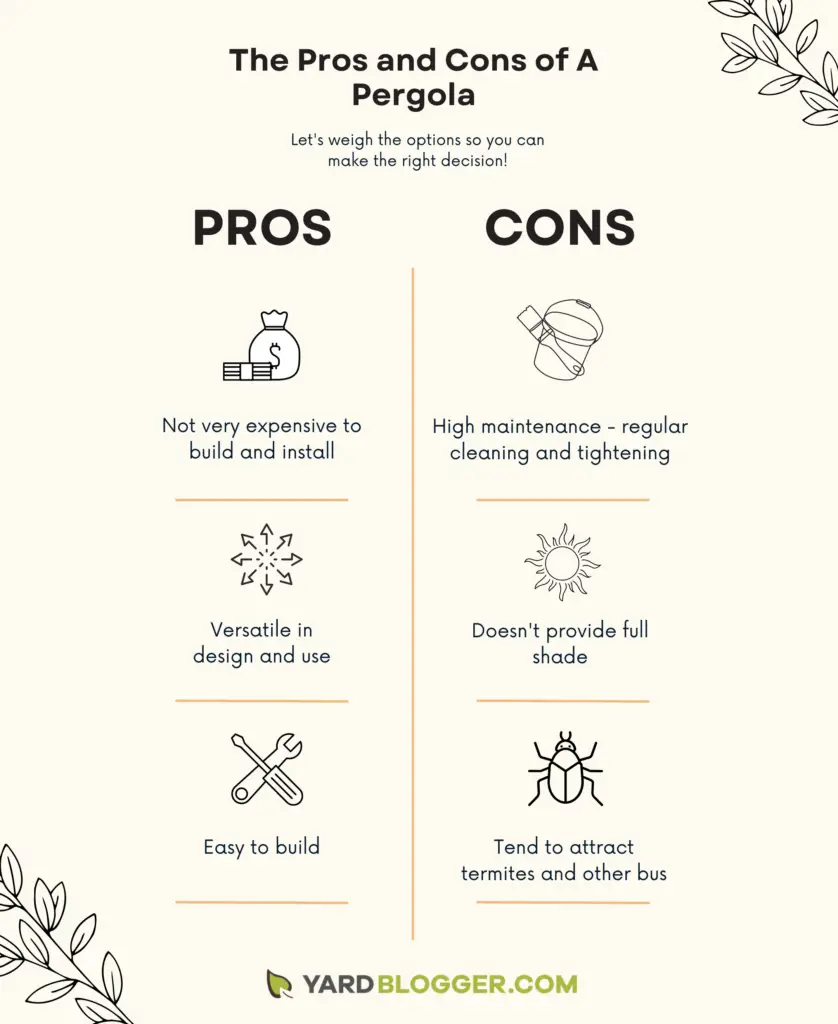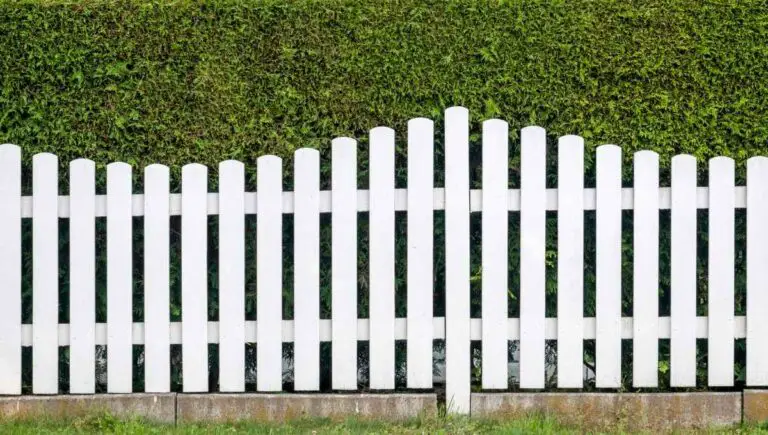Do I Need a Permit for a Pergola? (Here’s What’s Required)

When it comes to home improvement projects, adding a pergola is a great way to increase your extra outdoor living space. But do you need a permit for a pergola? What are the requirements?
Most states require a permit to build and install a pergola. Depending on what your pergola will include, you may need additional plumbing, electric, and gas permits. Before starting your project, always check with your local building department for specific requirements and regulations.
Luckily, a pergola is not as expensive as some other structures. In this article, we’re going to look at the requirements of building or buying a pergola and what the pros and cons are of installing a pergola in your yard.
This post contains affiliate links from Amazon and other stores. This means Yard Blogger may earn a commission if you make a purchase using any of our links. Please refer to our full affiliate disclosure policy for full details.
Here’s a Quick Pro Tip!
You can contact your local municipality to double-check if you need a permit to install a pergola or not. These are some essentials you might need if you plan to install a pergola.
Our favorite products from Amazon for your pergola:
1. Pre-Cut Pergola Kit – Ideal for a temporary pergola and no need for a permit.
2. Roller Shade Blinds – Perfect to have shade when you need it.
3. Wood Stain – Essential to keep your pergola well maintained and last longer.
All About Pergolas
Pergolas are elegant structures with a rich history in their books. So if you’re planning on installing a pergola in your yard, there are a few questions that you need answers for. Well, look no further.
Do You Need Permission to Build a Pergola?
Since a pergola is classified as a permanent structure, you will most likely need permission from your local municipality to build a pergola on your property. No matter if it is a residential or commercial property.
Like most other things, building codes and regulations differ per state.
Some might be extremely strict and require multiple permits, while other states are more lenient and would not require any permits to build a pergola.
It would be best to check with your local city municipality. For example, the city of Madison in Wisconsin has a Building Plan Submission CheckList specifically designed for pergolas.
How High Can I Build a Pergola?
In most states, a pergola’s highest point may not exceed 12 feet from the ground. The standard pergola is 8 – 10 feet high. However, this height restriction might differ depending on your county or state.
City officials enforce height restrictions on pergolas and gazebos to ensure safety. A strong wind could blow it over if your pergola is too high.
This can be a safety hazard to your own house and any other properties nearby.
How High Can a Pergola Be Without Planning Permission?
In some counties, a freestanding pergola that is less than 108 square feet does not require a permit. However, in other counties, you require a permit regardless of size or height.
There is no height limit which does not require building permissions. However, if you purchase a pre-cut pergola kit from Amazon, you would not need a permit as these are not seen as permanent structures.
Is a Pergola a Structure?
A pergola is considered an outdoor structure with four freestanding posts (usually) that support beams. Some prefer to leave the beams as is, and others prefer to cover the beams and create some shelter from the sun and rain.
Pergolas can be attached to another building, or they can be freestanding. In most cases, you would need building permissions to build and plan a pergola.
They’re becoming more popular in the states than ever before.
How Big Can a Pergola Be?
Pergolas have no real limit to their size. Usually, they are built over a deck and can be made the same size as the deck. Freestanding pergolas can also be as large as 16 x 20 feet, or even larger, depending on your ideal capacity.
A 16 x 20-foot pergola can seat about 12 people. That’s plenty big enough for most residential properties.
However, if you have a restaurant and want a pergola to cover multiple outside tables, it can be even bigger. There is no real limit to the size if your building plans are approved.
You might also enjoy our post on If a Pergola Can Have a Solid Roof
Privacy
Although pergolas are beautiful structures, they’re known for not being extremely private. You can do some things to make your pergola more private, though. Let’s dive into it!
What’s the Point of a Pergola?
Pergolas were designed to be a focal point in your backyard, but it’s more than mere decoration. Pergolas can offer shade to your deck/patio. Although they don’t traditionally offer complete shade, you can install a retractable canopy.
Many homeowners simply install pergolas to have an elegant and sleek structure in their backyard.
Homeowners with a green thumb will often grow wisteria, honeysuckle, or roses through the pergola to give the structure a ‘timeless’ effect.
Do Pergolas Provide Privacy?
There is a wide variety of pergola designs available on the market, and many of them do provide privacy. Many pergolas offer a complete roof specifically for shade and privacy reasons.
You can also install roller shade blinds on your pergola to have privacy when you require it and beautiful views when you don’t.
Pergolas are versatile and can be modified to fit your privacy needs.
Can I Put a Roof on My Pergola?
You can put a roof on virtually any pergola design, whether you are adding it to your building plans or adding a roof after the pergola has been built. Most carpenters will be able to install any roof that you desire.
Different roof options for a pergola:
- Retractable roof – This is ideal if you don’t want your pergola to be covered the whole time, only sometimes.
- Polycarbonate roofs – These are most often clear, so they are ideal if you enjoy natural light but want protection from other natural elements.
- Wood / shingled roof – These are great for resale value while fitting the style of your pergola.
What’s the Point of a Pergola Without a Roof?
Pergolas without a roof are designed to let in as much natural light as possible and circulate fresh air. These pergolas are not designed to provide shade but to be an elegant focal point of a yard.
Many families enjoy eating dinner outdoors in the summertime under a pergola. Others enjoy sitting in their garden and reading a book under a pergola.
The complete shade is not always needed, but if it is, a roof can be installed on the pergola.
You might also enjoy our post on If Pergolas are Wind-Resistant
How Do I Stop My Neighbors From Viewing My Yard?
Installing a fence is the best way to block your neighbor’s view of your yard. Usually, a 6-foot high fence is enough to keep your neighbors’ view of your yard blocked unless they have a second story to look out of.
If you do have a pergola, gazebo, or any other permanent structure in your yard, there is a way to make it even more private.
You can add fake (or real) plant privacy screens to block your neighbors’ view from a second-story window.
Placement of Your Pergolas
When you’ve decided that you want to install a pergola, the next big thing is to decide where you should install it.
Since it is a permanent structure, this is quite a big decision, and there are a few factors to keep in mind.
Can I Put a Pergola on My Deck?
Pergolas can be attached to your deck with one side connecting to your house, or they can be freestanding on your deck. It can also be designed to match the style and material of your deck to create a seamless look.
Pergolas are installed on decks to provide shade to the area or add an element of design to the deck. Many restaurants also install pergolas over their outdoor seating.
Pergolas can also have a retractable roof to provide full shade when needed.
Where Can a Backyard Pergola Be Placed?
A pergola can be placed virtually anywhere in your backyard. It can be attached to your house or freestanding. It can be built on wood decks, concrete slabs, pavers, or the ground. There are no actual limits to pergola placements if you do proper planning.
There are, however, some practical tips to keep in mind. Rafters oriented north to south will provide a lot more shade than rafters oriented east to west.
Place your gazebo near your entertainment area, like the pool or the grill.
What Do You Put Under a Pergola?
You can put anything you can think of under a pergola. It’s mostly used as an outdoor entertainment/lounge area with outdoor furniture. Some also use it as an outdoor dining area.
The possibilities are truly endless, but of course, you would not want to put something that is not water-resistant under your pergola.
Television would not be a good idea unless you install a roof on your pergola.
Pergola FAQ’s
Reading through this article, you’ve probably gotten answers to all your questions about pergolas, but there are some other frequently asked questions. In this section, we’re going to answer these questions.
What Are the Pros and Cons of a Pergola?
The biggest pro of a pergola is the price. It’s generally not very expensive to install a pergola in your yard. The biggest con of a pergola is that they require a lot of maintenance and can attract termites.

Pros of owning a pergola:
- Pergolas are not very expensive as they do not need a lot of material.
- Pergolas are versatile. You can use them for many situations and customize the structure as you want.
- Pergolas are relatively easy to build or DIY.
Cons of owning a pergola:
- Pergolas need to be treated and cleaned regularly. It might also need to be repainted once a year or so.
- Pergolas don’t offer complete shade, and to some, it is not a practical structure.
- Pergolas made of wood are prone to attract termites or other wood-damaging insects.
What Is a Pergola With Walls Called?
A pergola with walls is still called a pergola. There is no alternative name since the structure is very versatile. You can add a roof or walls to a traditional pergola and still call it a pergola.
Many people do add a wall to their pergola for privacy from their neighbors or to block direct sunlight.
Roller shade blinds are very convenient since you can decide when you want to close or open the ‘walls.’
What’s a Covered Pergola Called?
A pergola with a complete roof covering is referred to as a pavilion. Although sometimes they are still called a pergola, there is no definite title for a pergola that is covered.
Many homeowners prefer a pavilion style since it protects them from the natural elements much more than a traditional pergola.
A happy medium is installing a retractable roof to allow cover when needed and natural light when not.
You might also enjoy our post on If Pergola’s Need to be Anchored
Is It Cheaper to Build or Buy a Pergola?
It’s cheaper to buy a pergola with precut materials and everything already set out for you. You don’t waste unnecessary materials or spend a load of money on labor costs. Usually, you can DIY pergola kits that you buy.
Building a pergola can cost you between $2000 and $6000 (or even more), with a lot of variables. The labor cost and material costs can change at any minute.
Buying a pre-cut pergola kit can save you money and time as they usually are between $1000 – $2000.
How Long Will a Wood Pergola Last?
With no maintenance and care, you can expect a wood pergola to last about five years. However, if you regularly clean and treat the wood, you can expect your pergola to last up to 10 years.
Regularly clean your pergola with an all-purpose cleaner and some warm water. You should re-stain your wooden pergola every second year or as often as you notice wear and tear.
It’s best to use a water-based wood stain.
Related Questions
How Tall Can a Gazebo Be Without Planning Permission?
There is no minimum height to build a gazebo without planning. However, there is a minimum size. If your gazebo is 10 x 10 feet or smaller, you probably won’t need a permit to build it.
The building codes and regulations are different per state, so you should check with local city officials even if you’re planning on building a 10 x 10 gazebo.
10 x 10 is quite small, though, so you will probably want a bigger gazebo.
Do I Need Planning Permission for a Covered Patio?
A covered patio, sometimes called a pergola, usually requires a building permit since it is defined as a permanent structure. Some states are more lenient than others, so you should ask your local municipality about their building codes.
Municipalities have building codes for covered patios to ensure the structural integrity and safety of the house to which it is attached.
In hurricane states, they tend to be more strict about anchoring and stabilizing your covered patio.
What Can I Use Instead of a Pergola?
Gazebos are a popular alternative to pergolas since they offer complete shade. These structures are usually hexagonal or octagonal shapes with a raised floor for entertainment or relaxation.
A pavilion is also an alternative to a pergola since it looks similar, but a pavilion has a covered roof. A pavilion usually has a fabric roof, so it can be taken down if necessary.
For an eco-friendly option, you could plant native trees surrounding your yard.
Final Thoughts
Pergolas are beautiful structures and can be built from scratch or bought with pre-cut materials.
Whichever route you decide to go, you should enquire with your local municipality if you need a building permit.












